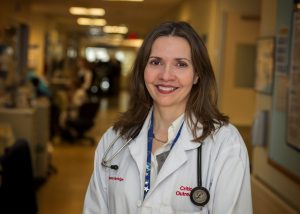Upcoming webinar explains new x-ray technology that may detect PF earlier

We know that one of the biggest challenges of pulmonary fibrosis is obtaining a timely diagnosis. Most patients wait close to a year, many wait much longer, before receiving a diagnosis. During this time, without treatment, patients’ lungs continue to deteriorate.
CPFF’s latest webinar, on November 18 at 1:30 p.m., EST, features two speakers uniquely suited to explain a new x-ray technology that may help physicians detect pulmonary fibrosis earlier than current chest x-rays. Register now for “Detecting pulmonary fibrosis earlier with new dual energy X-ray technology.”
Karim S Karim, Founder and Chief Technology Officer of KA Imaging and Dr. Patrik Rogalla of the University Health Network (UHN) will explain how imaging is typically used today for diagnosis and management of PF; how the new technology is better than traditional x-rays; how it works; how it can speed up diagnosis and treatment and where it is now available. During the live webinar, you’ll also have the opportunity to ask questions of the presenters.
Early insights into Canada-wide study of effects of COVID-19

CPFF was privileged to host the two co-lead investigators of CANCOV: The Canadian COVID-19 Prospective Cohort Study as presenters of a live webinar on October 15, 2021. The video of the presentation is now available for viewing at any time.
Dr. Angela Cheung and Dr. Margaret Herridge, both with the University Health Network in Toronto, shared early insights from the study on the short and long-term impact of COVID -19 on patients and family caregivers. They also answered several audience questions regarding vaccines and the continuing risk of COVID-19 in vulnerable people, like those with pulmonary fibrosis.
The CANCOV study involves more than 100 investigators from centres across the country, in both large, teaching hospitals and in smaller, community hospitals. To date, more than 1,700 patients and caregivers have been enrolled in the study, some who were not hospitalized, others who were hospitalized, but not in ICU, and those who were admitted to ICU. The investigators hope to enroll 1,000 non-hospitalized patients, 1,000 hospitalized patients and 100 caregivers.
The overall objectives of the study are to determine the short and long-term outcomes of patients with COVID-19 and their caregivers in Canada, and to examine the sociodemographic, clinical, and other predictors of these outcomes. The study is currently set to follow patients for one year, but researchers hope to extend the study to two years.
Information is gathered at baseline, seven days, one month, three months, six months and 12 months. “We’re looking at the whole person, not just medical test results,” says Dr. Cheung. Data collected includes: sociodemographic data, comorbid illness (other conditions), medications, primary daily activity, work status, symptoms, quality of life, mental health, resilience, stigma, complications, nutrition status, physical exam and function, health care utilization and reintegration.
Although there are many names, such as “long haulers,” for those experiencing COVID symptoms for an extended period of time, the WHO (World Health Organization) refers to extended symptoms as “Post-COVID condition.”
“COVID-19 is a multi-system disease,” says Dr. Cheung, “and in addition to lung damage, it can affect the heart, kidneys, liver, brain, nerves, digestion, hormones and cause skin conditions.” No surprise that there are more than 100 symptoms, resulting consequences, or difficulties conducting usual activities reported by patients.
A review by PHAC (Public Health Agency of Canada) has found that the most prevalent symptom is fatigue – in about 50 per cent of patients in the short term (four to 12 weeks) and long-term (greater than 12 weeks). Other symptoms such as general pain and discomfort, sleep disturbances, shortness of breath and anxiety and depression occur in both the short-term and long-term, but to a lesser degree long term. It is worth noting that nine per cent of patients at 12 weeks, had not returned to work.
So far in the CANCOV study, in the non-ICU group of patients without prior respiratory problems, they’ve seen the following results:
- Shortness of breath, especially with exertion. This is treated with breathing exercises.
- Cough, wheeze. This is treated with steroid inhalers.
- Oxygen saturation with six-minute walk test is normal for most patients.
- Almost all chest x-rays are normal by three months.
- Pulmonary function tests are consistent with weak respiratory muscles. This is treated with breathing exercises.
- No patients require oxygen at three months unless they have prior pulmonary disease.
- They have not diagnosed pulmonary fibrosis as a result of COVID-19.

Dr. Herridge, began her part of the presentation, by comparing COVID-19 to SARS. She then discussed various published studies on the experiences of different nations in dealing with COVID-19, including the U.S., China, France and Brazil, among others.
As a respirologist who has been treating COVID-19 patients at Toronto General Hospital, she spoke about the waves of disease we have seen here in Canada. “With the Delta variant, we have seen patients in their 30s and 40s in the ICU, who do not necessarily have other, underlying conditions. And today, all current COVID patients in our hospital are unvaccinated or immunocompromised patients and there are many patients in their 20s and 30s. People in their 20s and 30s are dying from COVID-19.”
She also discussed the long road to recovery for those who have survived an ICU stay for COVID-19. “Like many ICU patients, they can develop what we call ‘ICU-acquired” nerve and muscle weakness.” ICU patients can also experience cognitive dysfunction, PTSD, anxiety and depression. Some patients may require readmission to the ICU, or to the hospital, and may need to see specialists in follow-up. In addition to the health and physical challenges, an extended illness can also have emotional and financial ramifications. Something people living with PF know well.
Dr. Herridge was adamant in advising people to be vaccinated against COVID-19. “And those with underlying health issues, such as ILD, will be more susceptible, because they have less reserve to fight this multi-system disease.” She also encourages those who are taking immunosuppressants, to get a third dose of the vaccine when it is offered.
Both doctors also recognize that the vaccines greatly mitigate, but do not totally eliminate the risk of contacting COVID-19. If you are vulnerable, or live with someone who is, you should continue to take other precautions, even if you are double-vaccinated, they say. Continue to avoid crowds and wear a mask if you cannot be physically distant, especially indoors. They also remind people to get their flu vaccine this fall.
Looking ahead, neither doctor will be surprised if a COVID-19 vaccine becomes a yearly vaccine, dealing with virus mutations. Time will tell when current vaccine immunity begins to wane and another dose is needed. “It will be an evolving situation,” says Dr. Herridge, “in much the same way that we receive other vaccines, such as getting a tetanus shot every 10 years.”

Lung cancer doesn’t have to be a death sentence, even for those living with ILD, according to Dr. Shane Shapera, Director of the Interstitial Lung Diseases Program at the Toronto General Hospital. In his September webinar, Dr. Shapera discusses the growing problem of lung cancer in people living with ILD. If you missed the live presentation, you can watch the video now at any time.
Dr. Shapera discussed the prevalence of lung cancer in ILD patients, the challenges of diagnosis and “staging” the disease, the risks and benefits of surgery, radiation and chemotherapy, and the possibility of lung transplant for ILD patients with lung cancer.
Lung cancer is common in patients with interstitial lung disease with more than 20 per cent of people with IPF developing lung cancer. It is also a common scleroderma-associated cancer. Data is not available for other ILDs.
ILD shares common risk factors for cancer, including: smoking and/or emphysema; exposure to asbestos, silica and other chemicals and underlying connective tissue disease.
ILD and lung cancer also share common mechanisms with cancer commonly developing within areas of lung fibrosis. Similar observations are seen in other organs, with liver fibrosis causing liver cancer.
As for diagnosis, Dr. Shapera clearly explains the usual lung cancer diagnostic tools (tissue samples taken using bronchoscopy directed biopsy or CT-directed biopsy ) and the challenges of using them on ILD patients. A bronchoscopy is better for taking samples in the central parts of the lung, but fibrosis and tumours are more likely in peripheral areas of the lung in ILD patients. And a CT-directed biopsy can temporarily collapse a lung, which can be a serious issue for ILD patients.
“Maybe we don’t have to make a pathologic diagnosis,” says Dr. Shapera. “A growing nodule in an ILD patient is usually cancer and ‘proof’ is often not needed.” Any decision to proceed with biopsies should be made on a case-by-case basis.
Determining the “stage” of lung cancer can be another challenge for ILD patients. Dr. Shapera explains each stage and how it is usually determined and how best to determine the stage of cancer in ILD patients. A PET scan is probably the best method for staging lung cancer in people with ILD, but access can be limited. The PET scanning machines are large, expensive and difficult to use, so they are usually only available in cancer centres in large cities.
Dr Shapera walks us through the various options for cancer treatment, including surgery, radiation and chemotherapy. Even within each type of cancer treatment, there are various options to consider, depending on the stage of the cancer, each with differing risk/benefit profiles.
Although chemotherapy is not well tolerated by people with ILD, it is interesting to note that nintedanib is approved for use as second line cancer therapy (marketed as Vargatef™).
Sometimes the biggest hurdle for treatment, is overcoming health care professionals’ reluctance to treat lung cancer in ILD patients at all. The questions become how likely is the patient to die from the cancer? From the ILD? Or from the cancer treatment? It’s a complicated situation.
In general, ILD patients receive less aggressive cancer care based on registry data. ILD patients with stage 1 to 3 cancer are less likely to receive surgery (68 per cent vs. 83 per cent for patients without ILD). About 29 per cent of IPF patients received no specific anti-cancer therapy.
“If possible, we should try to be more aggressive in treating lung cancer in ILD patients,” says Dr. Shapera. Untreated lung cancer has a high mortality and up to 50 per cent of patients with ILD and lung cancer will die from cancer.
Several scoring systems exist to predict risk of surgery, radiation and chemotherapy. These complex risk scores are rarely incorporated into clinical practice. “A tool which calculates a GAP score can predict ILD related mortality and has been my go-to tool to help with decision making,” says Dr. Shapera.
Finally, are ILD patients who get lung cancer no longer be eligible for a lung transplant? “Transplant may still be an option for a highly select group of ILD patients with early-stage lung cancer,” says Dr. Shapera.
The presence of active cancer is an absolute contraindication for transplant and anti-rejection drugs increase the risk that cancer (if present) will grow. Lung transplant may be considered in very selected patients with:
- Very severe ILD (otherwise appropriate for lung transplant)
- Otherwise deemed to be an acceptable candidate for transplant listing
- Early-stage lung cancer having received therapy with “curative intent.”
Dr. Shapera urges ILD patients to advocate for cancer treatment and lung transplant in several ways. “Learn all you can about your disease from reliable sources. The CPFF is a treasure trove of information,” he says. “And, be young at heart. Some 50-year-olds act as if they are 90. Maintain your health and fitness to the best of your ability and remain engaged in the world and look to the future.”
For more detailed information about lung cancer and ILD, watch Dr. Shapera’s video and for videos with other health care experts on a variety of topics about ILD and pulmonary fibrosis, watch other recent CPFF educational sessions online at www.hopebreatheshere.com.
Promising PF drug therapies on the horizon

During his September presentation on drug therapies for pulmonary fibrosis, Dr. Martin Kolb shared information about current clinical trials that are showing some promise at improving the disease course, and/or quality of life, for people living with pulmonary fibrosis. If you missed the live broadcast, you can watch a video of his session anytime online.
“In the not-too-distant future, I can see that we will have therapies that stop the progression of pulmonary fibrosis,” he says. But, for now, we have medications that can slow the progression of PF and there is plenty of work underway investigating the effectiveness of new compounds to slow lung fibrosis, as well as drug combinations, and investigations into new drugs and non-pharmacological therapies that address specific symptoms and side effects, to improve quality of life, he adds.
Dr. Kolb begins his session with an overview of PF diagnosis and prevalence. He noted that up to 200 of every 100,000 people over 65, have pulmonary fibrosis. And because lung damage cannot be reversed, it is important to receive a diagnosis and be offered appropriate treatment as soon as possible to slow decreasing lung function.
For idiopathic pulmonary fibrosis (IPF), the standard of care includes anti-fibrotic drugs and antacids, and not immunosuppressant drugs. Dr. Kolb goes into some detail on how the two anti-fibrotic drugs, pirfenidone and nintedanib, work and their efficacy and side effects.
Randomized, double-blind, clinical trials are the gold standard for investigating the efficacy of new compounds in treating PF. Most important is that safety checks are constant and data safety monitoring committees can recommend termination of a clinical trial at any time.
Dr. Kolb shared a list of 17 phase II and phase III clinical trials currently underway for IPF treatments. He made note of two, phase II trials that look particularly promising: pentraxin and pamrevlumab. He also shared information about clinical trials that are now, or will soon be, recruiting for participants. Depending on where you live, you might be interested.
Dr. Kolb closed by noting that PF management involves so much more than drug therapies, from nutrition to oxygen and from exercise and pulmonary rehab to updated vaccines. “A multi-disciplinary approach, supporting the whole person is the way to best manage this complex disease and live your best possible life.”
CPFF is pleased to offer a full range of educational videos to help you do just that. Check them out at www.hopebreatheshere.com.
PanAmerican Seed supports PF research

Ruud Brinkkemper, General Manager for PanAmerican Seed’s facility in the Netherlands, spent years with his team seeking a solution to an air-borne fungus that infected impatiens plants around the world for almost 15 years.
“We never thought that we would find a solution, but we did,” says Ruud, “through many years of genetic research. It is a natural solution that prevents the fungus and is much healthier for the environment than treating the plants with chemicals.”
In the same way, PanAmerican Seed hopes that research into human diseases, such as pulmonary fibrosis, will reveal answers and lead to treatments and a cure. The company now commits a percentage of its global sales of seeds for the Beacon Impatiens to less known disease organizations.
For 2021, CPFF will receive a donation of $50,725 that will be used to support our research efforts. An equal amount will be given to Pendersfonds, a patient platform in the Netherlands, which raises money for research into pulmonary fibrosis.
Brinkkemper has a personal stake in supporting PF research. Several members of his family have had pulmonary fibrosis, including his mother who lives with it now and his grandmother, who died from the disease. “Research gives us hope, if not for my mother, then for my children,” he says.
In much the same way that the Beacon Impatiens brings light to the shade – impatiens are a colourful, bedding plant that thrive in shaded areas – PanAmerican Seed hopes to shed light on diseases that are not readily recognized and supported by the public or governments.


